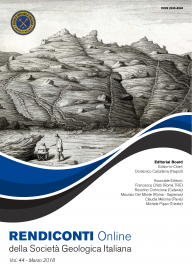
Genesis of carbonate-rich veins in the serpentinites at the Calabria-Lucania boundary (southern Apennines)
Maria Chiara Dichicco (1), Pedro Castiñeiras (2), Carmen Galindo Francisco (3), Laura González Acebrón (4), Fausto Grassa (5), Salvatore Laurita (1), Michele Paternoster (1,5), Giovanna Rizzo (1), Rosa Sinisi (1) & Giovanni Mongelli (1)
(1) Department of Sciences, University of Basilicata, 85100 Potenza, Italy.
(2) Departamento de Petrología y Geoquímica, Universidad Complutense, Madrid, España.
(3) CAI - Geocronología y Geoquímica Isotópica, Universidad Complutense Madrid, España.
(4) Departamento de Estratigrafía, Universidad Complutense, Madrid, España.
(5) INGV - Sezione di Palermo - (Istituto Nazionale di Geofisica e Vulcanologia), 90146 Palermo, Italy.
Corresponding author e-mail: maria.dichicco@unibas.it.
DOI: https://doi.org/10.3301/ROL.2018.20
Volume: 44/2018
Pages: 143-149
Abstract
In the northern sector of the Pollino massif (southern Apennines, Italy) well-exposed lens-shaped bodies of serpentinites and sediments of the Frido Unit belonging to the Liguride Complex crop-out. Most serpentinite rocks are cross-cut by carbonate and quartz-carbonate veins with different thickness. This study focuses on petrographic, mineralogical, geochemical, and isotopic analysis of the carbonate veins embedded in serpentinite rocks, collected at the Fosso Arcangelo site and at the Pietrapica quarry (Calabria-Lucanian boundary). The paragenesis of the carbonate veins from the Fosso Arcangelo site is dominantly made by calcite and aragonite with minor amount of rhodochrosite. In quartz-carbonate veins from Pietrapica quarry, dolomite, Mg-calcite, quartz, with minor ankerite were observed.
The δ13CV-PDB isotope ratios of carbonates in the carbonate veins are in the range from +2.16‰ to -3.66‰ and corresponding δ18OV-SMOW values are between +15.02‰ and +21.53‰. The δ13CV-PDB values of carbonates in quartz-carbonate veins are in the range from -3.60‰ to -1.78‰ and the corresponding δ18OV-SMOW average value is around +21.3‰. The results suggest that the carbonate at both site occurredunder the same environmental conditions from crustal-derived and
low-moderate temperatures hydrothermal fluids having different chemical composition.
Keywords
Get Full Text